Multimodal Marketing: The Future of Social Media Engagement
MultiModal Social Pro, led by Jeanne Kolenda, offers a comprehensive approach to enhance social media engagement through multimodal content strategies.
Recognizing the limitations of traditional static posts, the platform emphasizes integrating various media types text, images, videos, and audio to create dynamic, engaging content that captures audience attention.
Their services include a complete social media strategy, post idea generators, ready-to-use templates, and a detailed blueprint for planning and scheduling content.
By adopting these multimodal techniques, businesses can boost engagement by up to 200%, expand their reach, and convert followers into customers.
The platform also highlights the importance of daily posting, offering tools and strategies to maintain consistency without feeling overwhelmed.
In the ever-evolving world of digital marketing, brands must continuously adapt to stay relevant.
Social media platforms are saturated with content, making it increasingly difficult to capture and retain audience attention.
The key to cutting through this noise lies in multimodal marketing—a strategy that combines various content formats such as text, visuals, videos, and audio to create a dynamic, immersive experience.
By leveraging multimodal content, businesses can significantly enhance engagement, expand their reach, and improve lead generation, ultimately driving sales.

>> CLICK HERE TO GET INSTANT ACCESS TO MULTIMODAL MARKETING <<
The Power of Multimodal Social Marketing
Enhancing Engagement with Multi-Sensory Content
Engagement is the lifeblood of social media success. With millions of posts flooding platforms daily, brands must employ innovative strategies to stand out.
Multimodal content leverages diverse formats, catering to different user preferences and consumption habits.
Studies have shown that engagement can increase by up to 200% when various media types are integrated into a content strategy.
For instance, pairing an eye-catching visual with a compelling caption increases the likelihood of audience interaction.
Adding short-form videos or interactive elements like polls and quizzes further enhances the user experience.
Additionally, audio elements such as podcasts or voiceovers add a personal touch, fostering deeper connections with the audience.
Reaching a Broader Audience Through Algorithm Optimization
Social media algorithms favor content that promotes engagement and retention.
Platforms like Instagram, Facebook, LinkedIn, and TikTok reward creators who utilize multiple content types by increasing their visibility in users’ feeds.
By diversifying content formats, brands can maximize their reach and tap into broader demographics.
For example, an educational post about a new product can be delivered in several ways: an informative blog article, an engaging infographic, a short explainer video, and an accompanying podcast episode.
This diversified approach ensures content resonates with different audience segments, thereby improving organic reach and social media performance.
Boosting Brand Awareness and Lead Generation
A well-executed multimodal strategy does more than enhance visibility; it also strengthens brand recognition and drives conversions.
Consumers are more likely to remember a brand that provides consistent, high-quality content across multiple touchpoints.
By delivering information in various formats, businesses reinforce key messages and nurture potential leads.
Consider an e-commerce brand launching a new product.
A promotional campaign featuring teaser videos, carousel posts showcasing product benefits, in-depth blog reviews, and influencer-led unboxings creates a compelling narrative.
Prospective customers encountering content in different formats are more likely to engage and move further along the buyer’s journey.
Key Strategies for Implementing Multimodal Social Marketing
Diversify Content Creation
A successful multimodal approach starts with a robust content plan. Brands should experiment with different formats to determine what resonates best with their audience. Options include:
- Text-Based Content: Blog posts, captions, and articles for storytelling and informative insights.
- Visuals: Infographics, memes, and images to make complex information more digestible.
- Videos: Short-form clips, live streams, and tutorials to boost engagement.
- Audio: Podcasts and voice notes to connect with audiences on the go.
Optimize for Platform-Specific Features
Each social media platform has unique strengths. Instagram thrives on high-quality visuals and reels, whereas LinkedIn favors long-form articles and professional discussions.
TikTok capitalizes on short, entertaining videos, while Twitter is ideal for quick updates and conversational engagement.
By tailoring content to platform-specific strengths, brands can maximize their impact.
Utilize AI and Data Analytics
Artificial intelligence (AI) tools and data analytics help brands understand what content performs best.
Insights into audience behavior, engagement rates, and content preferences allow marketers to refine their approach.
AI-powered tools also assist in content generation, personalization, and automation, streamlining the multimodal strategy.
Encourage User-Generated Content
User-generated content (UGC) strengthens credibility and fosters community engagement.
Encouraging followers to share their experiences through photos, testimonials, and video reviews builds social proof and enhances brand trust.
Featuring UGC across different formats further amplifies reach and authenticity.
Integrate Interactive Elements
Interactivity boosts engagement by making content more participatory.
Features like polls, quizzes, Q&A sessions, and live chats encourage audience involvement. Gamification techniques, such as contests and rewards, also drive higher interaction levels.

The Future of Multimodal Social Media Marketing
With the rapid advancement of digital technologies, the demand for immersive and dynamic content will only grow.
Emerging trends, such as augmented reality (AR) and virtual reality (VR), will further enrich the multimodal experience.
Brands that adapt early to these innovations will maintain a competitive edge.
Moreover, consumer preferences are shifting toward authentic, personalized experiences.
Businesses that focus on storytelling, community-building, and diversified content strategies will thrive in the evolving digital landscape.
Conclusion
Multimodal marketing is no longer optional; it is the future of social media engagement.
By blending text, visuals, video, and audio, brands can create compelling, multi-sensory experiences that captivate audiences.
This approach enhances engagement, broadens reach, and drives customer acquisition.
As social media algorithms continue to evolve, those who embrace content diversity will remain at the forefront of digital marketing success.
For businesses looking to stay ahead, implementing a well-structured multimodal strategy is essential.
By leveraging various content types and optimizing for platform-specific strengths, brands can maximize their impact, build stronger relationships with their audience.
And drive sustained growth in an increasingly competitive digital space. GRAB IT FAST!!!
>> CLICK HERE TO GET INSTANT ACCESS TO MULTIMODAL MARKETING <<